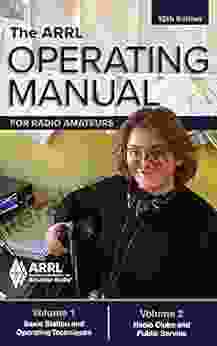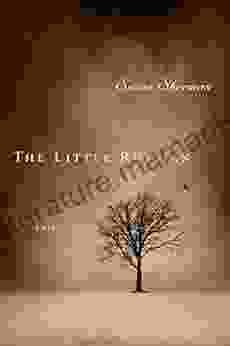The ARRL Operating Manual for Radio Amateurs: A Comprehensive Guide to Operating Procedures and Etiquette

The ARRL Operating Manual for Radio Amateurs is the definitive guide to operating procedures and etiquette for amateur radio operators. It covers everything from basic operating procedures to advanced techniques, and is an essential resource for any ham radio operator.
4.8 out of 5
| Language | : | English |
| File size | : | 33536 KB |
| Text-to-Speech | : | Enabled |
| Screen Reader | : | Supported |
| Enhanced typesetting | : | Enabled |
| Print length | : | 450 pages |
| Lending | : | Enabled |
The manual is divided into three main sections:
- Basic Operating Procedures: This section covers the basics of operating an amateur radio station, including how to set up your station, how to make contacts, and how to exchange information with other operators.
- Advanced Operating Techniques: This section covers more advanced operating techniques, such as how to use digital modes, how to operate on HF bands, and how to participate in contests.
- Etiquette: This section covers the etiquette of amateur radio operating, including how to behave on the air, how to respect other operators, and how to avoid causing interference.
The ARRL Operating Manual for Radio Amateurs is a must-have resource for any ham radio operator. It is a comprehensive guide to operating procedures and etiquette, and it can help you to become a more proficient and courteous operator.
Table of Contents
- Basic Operating Procedures
- Advanced Operating Techniques
- Etiquette
Basic Operating Procedures
The basic operating procedures section of the ARRL Operating Manual covers everything you need to know to get started operating an amateur radio station. It includes information on how to set up your station, how to make contacts, and how to exchange information with other operators.
Setting Up Your Station
The first step in operating an amateur radio station is to set up your station. This includes choosing a location for your station, assembling your equipment, and setting up your antenna.
When choosing a location for your station, it is important to consider the following factors:
- Space: You will need enough space to accommodate your equipment and antenna.
- Accessibility: You will need to be able to easily access your station in order to operate it.
- Interference: You will want to choose a location that is free from interference from other sources, such as power lines and electrical equipment.
Once you have chosen a location for your station, you can begin assembling your equipment. The basic equipment you will need includes a transceiver, an antenna, and a power supply.
The transceiver is the heart of your amateur radio station. It is used to transmit and receive radio signals. The antenna is used to send and receive radio waves. The power supply provides the power for your transceiver.
Once you have assembled your equipment, you can set up your antenna. The type of antenna you use will depend on the bands you want to operate on.
Making Contacts
Once your station is set up, you can begin making contacts. To make a contact, you need to find another amateur radio operator to talk to. You can find other operators by listening to the airwaves or by using a callbook.
When you find another operator to talk to, you can begin a conversation. The conversation can be about anything, but it is common to talk about your equipment, your operating experience, and your interests.
Exchanging Information
When you are talking to another operator, you can exchange information. This can include your name, your callsign, your location, and your operating frequency.
You can also exchange information about your equipment, your operating experience, and your interests. Exchanging information is a great way to get to know other operators and learn about the hobby.
Advanced Operating Techniques
The advanced operating techniques section of the ARRL Operating Manual covers more advanced operating techniques, such as how to use digital modes, how to operate on HF bands, and how to participate in contests.
Using Digital Modes
Digital modes are a popular way to communicate on the airwaves. Digital modes use a computer to encode and decode the audio signal, which allows for a more efficient use of the bandwidth.
There are many different digital modes available, each with its own advantages and disadvantages. Some of the most popular digital modes include:
- PSK31: PSK31 is a popular digital mode that is used for short-distance communication. It is a relatively simple mode to use, and it can be used on a variety of bands.
- RTTY: RTTY is a digital mode that is used for long-distance communication. It is a more complex mode to use than PSK31, but it can be used to communicate over longer distances.
- JT65: JT65 is a digital mode that is designed for weak-signal communication. It is a very efficient mode, and it can be used to communicate over long distances with low power.
Operating on HF Bands
The HF bands are the frequencies between 3 MHz and 30 MHz. The HF bands are used for long-distance communication, and they are often used for international contacts.
Operating on the HF bands can be more challenging than operating on the VHF or UHF bands. The HF bands are more susceptible to interference, and the propagation conditions can be more variable.
If you are interested in operating on the HF bands, it is important to learn about the propagation conditions and how to use different antennas to maximize your signal.
Participating in Contests
Contests are a popular way to compete with other amateur radio operators. Contests are held on a variety of bands and modes, and they can be a lot of fun.
If you are interested in participating in contests, it is important to learn the rules of the contest and how to use the correct operating procedures.
Etiquette
The etiquette section of the ARRL Operating Manual covers the etiquette of amateur radio operating. It includes information on how to behave on the air, how to respect other operators, and how to avoid causing interference.
Behaving on the Air
When you are operating on the air, it is important to behave in a courteous and respectful manner. This includes being polite to other operators, avoiding profanity, and avoiding transmitting unnecessary information.
It is also important to be aware of the operating procedures for the band you are operating on. For example, on some bands it is considered good etiquette to use a callsign suffix to indicate your location or your operating mode.
Respecting Other Operators
It is important to respect other operators on the air. This includes listening before you transmit, not interfering with other operators, and not transmitting over other operators.
It is also important to be aware of the operating privileges of other operators. For example, some operators may only be licensed to operate on certain bands or modes.
Avoiding Causing Interference
It is important to avoid causing interference to other operators. This includes avoiding transmitting on the wrong frequency, using excessive power, and not using a proper antenna.
If you are causing interference to another operator, you should apologize and move to a different frequency or mode.
The ARRL Operating Manual for Radio Amateurs is a comprehensive guide to operating procedures and etiquette for amateur radio operators. It is an essential resource for any ham radio operator, and it can help you to become a more proficient and courteous operator.
4.8 out of 5
| Language | : | English |
| File size | : | 33536 KB |
| Text-to-Speech | : | Enabled |
| Screen Reader | : | Supported |
| Enhanced typesetting | : | Enabled |
| Print length | : | 450 pages |
| Lending | : | Enabled |
Do you want to contribute by writing guest posts on this blog?
Please contact us and send us a resume of previous articles that you have written.
 Top Book
Top Book Novel
Novel Fiction
Fiction Nonfiction
Nonfiction Literature
Literature Paperback
Paperback Hardcover
Hardcover E-book
E-book Audiobook
Audiobook Bestseller
Bestseller Classic
Classic Mystery
Mystery Thriller
Thriller Romance
Romance Fantasy
Fantasy Science Fiction
Science Fiction Biography
Biography Memoir
Memoir Autobiography
Autobiography Poetry
Poetry Drama
Drama Historical Fiction
Historical Fiction Self-help
Self-help Young Adult
Young Adult Childrens Books
Childrens Books Graphic Novel
Graphic Novel Anthology
Anthology Series
Series Encyclopedia
Encyclopedia Reference
Reference Guidebook
Guidebook Textbook
Textbook Workbook
Workbook Journal
Journal Diary
Diary Manuscript
Manuscript Folio
Folio Pulp Fiction
Pulp Fiction Short Stories
Short Stories Fairy Tales
Fairy Tales Fables
Fables Mythology
Mythology Philosophy
Philosophy Religion
Religion Spirituality
Spirituality Essays
Essays Critique
Critique Commentary
Commentary Glossary
Glossary Bibliography
Bibliography Index
Index Table of Contents
Table of Contents Preface
Preface Introduction
Introduction Foreword
Foreword Afterword
Afterword Appendices
Appendices Annotations
Annotations Footnotes
Footnotes Epilogue
Epilogue Prologue
Prologue Karen Robards
Karen Robards Grant Corriveau
Grant Corriveau Matthew Continetti
Matthew Continetti Muhammad Adam Mubasher
Muhammad Adam Mubasher Catherine Moloney
Catherine Moloney Tony Rose
Tony Rose H P Gentileschi
H P Gentileschi Michaela Morgan
Michaela Morgan Faith Blum
Faith Blum Mark Stanton
Mark Stanton Paul Cronin
Paul Cronin Justina Ireland
Justina Ireland George Reisman
George Reisman Lope De Vega
Lope De Vega Dale A Olsen
Dale A Olsen Carrie Ann Ryan
Carrie Ann Ryan Zara Kaiserimam
Zara Kaiserimam Terry Collins
Terry Collins Celia Kinsey
Celia Kinsey Eric J Bailey
Eric J Bailey
Light bulbAdvertise smarter! Our strategic ad space ensures maximum exposure. Reserve your spot today!

 Dylan MitchellUnveiling the Profound Journey of Close My Eyes Closed: A Novel Exploring...
Dylan MitchellUnveiling the Profound Journey of Close My Eyes Closed: A Novel Exploring... Isaiah PowellFollow ·14.5k
Isaiah PowellFollow ·14.5k Fernando BellFollow ·8.8k
Fernando BellFollow ·8.8k Adrien BlairFollow ·5.8k
Adrien BlairFollow ·5.8k Arthur C. ClarkeFollow ·17.6k
Arthur C. ClarkeFollow ·17.6k Mason PowellFollow ·10.8k
Mason PowellFollow ·10.8k Rob FosterFollow ·15.6k
Rob FosterFollow ·15.6k Chinua AchebeFollow ·14.3k
Chinua AchebeFollow ·14.3k Chandler WardFollow ·15.1k
Chandler WardFollow ·15.1k

 Melvin Blair
Melvin BlairJames Wade's Captivating Tale: Delving into the Second...
In the heart of a realm where the veil...

 Eric Hayes
Eric HayesFabric Paper Thread: 26 Projects to Stitch with Friends
Get ready to embark on a captivating journey...

 Greg Foster
Greg FosterThe Grammy Awards Record of the Year 1958-2024: A...
The Grammy Awards, the most prestigious...

 Alex Foster
Alex FosterSaragarhi: The Forgotten Battle of the British Empire
On September 12,...
4.8 out of 5
| Language | : | English |
| File size | : | 33536 KB |
| Text-to-Speech | : | Enabled |
| Screen Reader | : | Supported |
| Enhanced typesetting | : | Enabled |
| Print length | : | 450 pages |
| Lending | : | Enabled |














